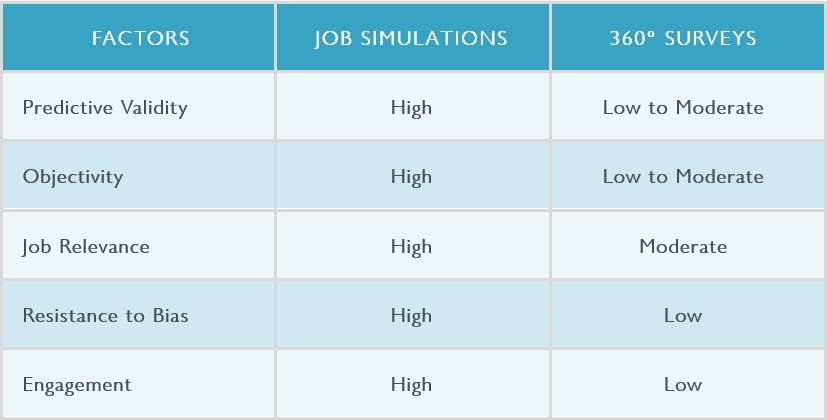In the ever-evolving world of talent management, organizations are under increasing pressure to identify and develop high-potential leaders who can navigate complexity, inspire teams, and drive results.
For years, one of the most widely adopted tools in leadership development has been the 360-degree feedback survey. However, while these tools can offer insights into interpersonal impact or team dynamics in current roles, they fall short in predicting leadership potential.
Today, a more effective and future-focused method is gaining traction: job simulations. Here’s why simulations are quickly becoming the gold standard in leadership assessment and development – and why they consistently outperform 360-degree surveys.
KEY DIFFERENTIATORS
1. Performance vs. Perception
The primary weakness of 360-degree surveys is that they are subjective. Feedback in these tools is filtered through people’s perceptions, personal opinions, and workplace dynamics. In addition, respondents might be evaluating the anticipated performance of someone who is not yet in a leadership role. This means they must project how they think the individual will perform, without ever seeing it on the job.
Ratings can be swayed by factors such as:
- Personal likability
- Internal competition
- Favoritism or grudges
Each rater may focus on different reasons for their evaluations which makes these tools inconsistent, often resembling a popularity contest rather than an objective review. In contrast, a well-designed job simulation provides a direct, objective measure of job-relevant performance – revealing how someone actually performs when faced with real workplace problems, decisions, and tasks.
Simulations give you objective evidence of leadership ability.
2. Higher Predictive Validity
Research consistently shows that simulations have greater predictive validity for future job performance than traditional survey tools. Because they depict real job situations, simulations offer a valid prediction of how a person will perform in a specific leadership role. In fact, the best leadership simulations are proven to identify leaders who are 2 to 5 times more likely to:
- Resolve work problems and negotiate compromises
- Balance business objectives with team and individual needs
- Communicate with clarity and enthusiasm
- Act quickly and strategically
- Set a positive example for their teams
Simulations accurately forecast job success.
3. Job Relevance
Leadership simulations are highly realistic, tailored to specific roles – whether it’s managing a team conflict, driving strategic planning, or responding to a crisis. This relevance ensures that assessments are closely aligned with actual job requirements. 360-degree feedback surveys tend to be more generic and may not accurately reflect the unique demands of a specific leadership role.
Simulations immerse candidates in real workplace challenges.
4. Resistance to Bias and Office Politics
Because simulations use standardized scenarios and scoring models, they help control against personal biases and political influence. This makes them more equitable and legally defensible, especially in high-stakes hiring and promotion decisions.
Simulations ensure fairness and consistency across candidates.
5. Better Engagement and Realism
Beyond their predictive power, simulations are also highly engaging. Candidates overwhelmingly prefer immersive simulations to static tests and surveys. Simulations allow participants to learn, reflect, and improve – making them not only an ideal assessment tool, but also a rich development experience.
Simulations provide immediate value for both the organization and the candidate.
COMPARISON OF SIMULATIONS VS 360-DEGREE SURVEYS

As organizations strive to build more effective and future-ready leadership pipelines, it’s time to look beyond traditional tools like 360-degree surveys.
Simulations, by contrast, provide a dynamic, fair, and accurate way to quickly identify true leadership potential. They strip away bias, focus on real-world performance, and offer actionable development insights that benefit both organizations and aspiring leaders.
The future of leadership development isn’t about who’s most popular, it’s about who leads best. Simulations make that future possible.
“There is no better way to crystallize and get leaders to practice what great leadership looks like at your company than through simulations.”
Jessica Skon and Ignacio Vaccaro, TrainingIndustry.com
TAKE A TEST DRIVE
ALSO CHECK OUT . . .
Finding and Developing Top Leadership Talent: A Skills-Based Approach


